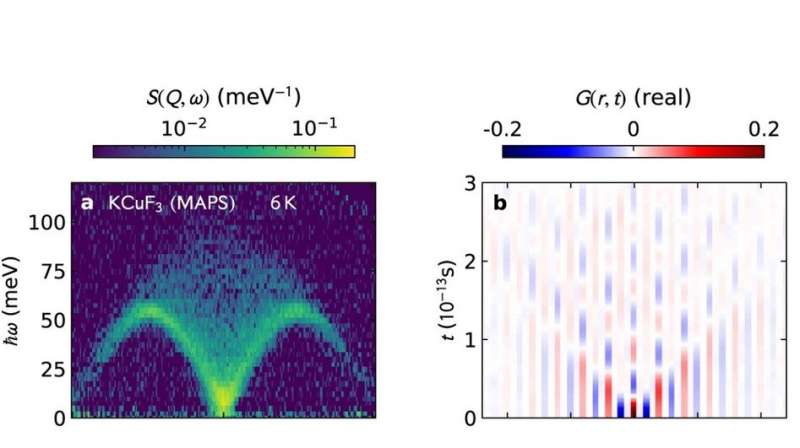Dynamics in one-dimensional spin chains: A new toolbox for elucidating future quantum materials

Neutron scattering is considered the method of choice for investigating magnetic structures and excitations in quantum materials. Now, for the first time, the evaluation of measurement data from the 2000s with new methods has provided much deeper insights into a model system—the 1D Heisenberg spin chains. A new toolbox for elucidating future quantum materials has been achieved.
Potassium copper fluoride (KCuF3 ) is considered the simplest model material for realizing the so-called Heisenberg quantum spin chain: The spins interact with their neighbors antiferromagnetically along a single direction (one-dimensional), governed by the laws of quantum physics.
"We carried out the measurements on this simple model material at the ISIS spallation neutron source some time ago when I was a postdoc, and we published our results in 2005, 2013 and again in 2021, comparing to new theories each time they became available," says Prof. Bella Lake, who heads the HZB-Institute Quantum Phenomena in Novel Materials. Now with new and extended methods, a team led by Prof. Alan Tennant and Dr. Allen Scheie has succeeded in gaining significantly deeper insights into the interactions between the spins and their spatial and temporal evolution.
Dynamics like a wake
"With neutron scattering, you sort of nudge a spin so that it flips. This creates a dynamic, like a wake when a ship is sailing through water, which can affect its neighbors and their neighbors," Tennant explains.
"Neutron scattering data is measured as a function of energy and wavevector," says Scheie. "Our breakthrough was to map the spatial and temporal development of the spins using mathematical methods such as a back-Fourier transformation." Combined with other theoretical methods, the physicists gathered information about interactions between the spin states and their duration and range, as well as insights into the so-called quantum coherence.
The work demonstrates a new tool box for the analysis of neutron scattering data and might foster a deeper understanding of quantum materials that are relevant for technological use.
More information: A. Scheie et al, Quantum wake dynamics in Heisenberg antiferromagnetic chains, Nature Communications (2022). DOI: 10.1038/s41467-022-33571-8
Journal information: Nature Communications
Provided by Helmholtz Association of German Research Centres




















